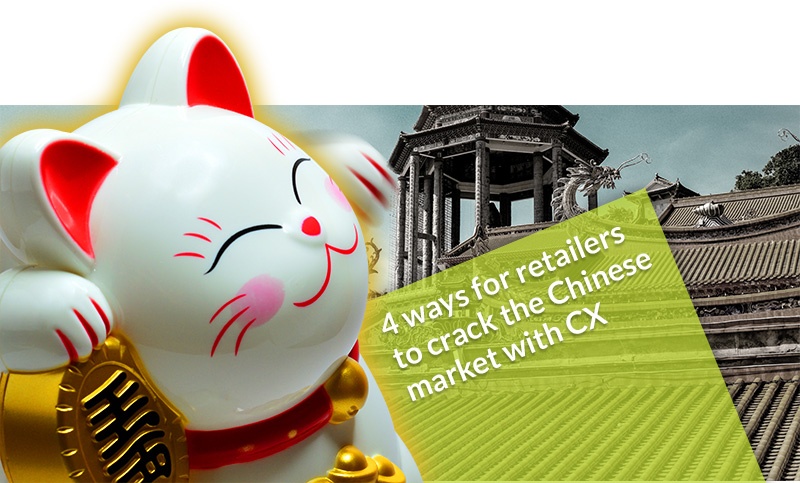Every business’s dream is to crack the Chinese market. Capture just 0.01%, and you’re set for a successful business.
We spoke to Gabriel Walker, director of Silk Cloud, who specialise in helping New Zealand businesses enter the Chinese market. In his words, “China is completely different in every way… There’s always stuff that surprises.”
So the question is, are Western businesses able to succeed in this foreign market? Our answer is a resounding YES. Besides getting the basics right (which Silk Cloud can help you with), the differentiating factor needs to be customer experience. Here are four ways we suggest optimising your customer experience to suit the Chinese market:
Make payment convenient with Chinese payment methods
Unlike the Western world, credit cards have barely penetrated the Chinese market. “There’s only one domestic card company that covers 14% of the population. They have a monopoly as far as market share goes though – the rest of the population just uses debit,” shares Gabriel. “China is not a credit-based economy; the Chinese traditionally save money and spend the money they have.” As a result, to provide a seamless customer experience, payment options need to be tailored accordingly.
With the advent of mobile payments, e-commerce really took off, with consumers paying via WeChat or AliPay. As of April 2018, Alipay had 520 million users, making an average of 175 million transactions per day – yet it’s not something that most Western users are accustomed to. Successful businesses need to make sure they’re using the payment methods that their audience in China are using, such as Alipay – one of the Chinese payment solutions available on Silk Cloud’s platform.
If your business is hoping to succeed in China and isn’t fully optimised for a Chinese-focused provider, you’re not providing your customers with the best experience possible.
Ensure your logistics are reliable
One of the most intimidating things about selling to China is logistics—how on earth do you ensure your product is turning up in the right place, at the right time? This may be challenging, but it’s absolutely vital to a stunning customer experience. If you’re selling online, as many businesses entering China will be, you need to be able to reliably deliver product in the timeframes you’ve promised.
Many Chinese ex-pats function out of Western countries, offering these kind of logistics services for high prices. However, this can cause issues for businesses who end up completely reliant on them and aren’t able to offer cost-effective shipping to Chinese customers. A great solution can be travelling to China and meeting with logistics companies yourself, but this can be time and cost-prohibitive for many, not to mention challenging. Shares Gabriel, “Logistics channels from NZ to China are incredibly mature and massively cheap – but it’s about who you know.”
Another option is to make sure you’re working through a provider who is open and transparent around their logistics suppliers and demonstrates how the costs get passed on to you. Whatever channel you choose, make sure you know exactly what kind of experience you’re providing on the ground in China.
It’s all about feedback
Given the high saturation of the Chinese market (Gabriel describes them as ‘the most spoilt market in the world’), it’s important to gain credibility and instil a sense of confidence in your product.
The way to do this is no different than in Western countries—gain real-time, reliable feedback from real customers, and share this with your prospective customers. “It’s a matter of establishing trust,” explains Gabriel. “Trust is even more important to the Chinese market – so getting customer reviews and having those in a place where they can see is vital.”
Take advantage of China’s strong influencer market to gain endorsements from those with large following, and find out what your first customers think, adjusting your product and customer experience to suit. Then keep doing that! Not only does this increase your chances of capturing market share; it also ensures you’re giving your customers the experience they’re looking for, every time.
Tell your story and build your brand
“Chinese consumers are advertised to all the time, everywhere they go,” shares Gabriel. “In New Zealand, we generally hope that the product does the work for us – if you make a good product, people will re-use it. However, in China, it defaults to how strong your brand is.”
The Chinese market has access to some of the cheapest and high quality products around – so how do you stand out from the crowd? It’s fairly simple – find a market, tell your story in a way that appeals to them, share that story through the channels they’re on daily, and make sure that the customer’s experience lives up to that story.
When you’re looking at breaking into the market, make sure you talk about where the product came from and why it’s so unique. Take into account what your initial Chinese customers have said about the product and incorporate that into your story. In China, good quality or a low price isn’t enough for a business to succeed – you need to know what makes your offering different, share that with the market, and then deliver on that promise.









